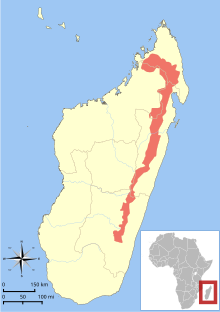Eulemur rubriventer
| Red-bellied lemur | |
|---|---|
 |
|
| Scientific classification | |
| Kingdom: | Animalia |
| Phylum: | Chordata |
| Class: | Mammalia |
| Order: | Primates |
| Suborder: | Strepsirrhini |
| Family: | Lemuridae |
| Genus: | Eulemur |
| Species: | E. rubriventer |
| Binomial name | |
|
Eulemur rubriventer I. Geoffroy, 1850 |
|
 |
|
| Distribution of E. rubriventer | |
| Synonyms | |
|
|
The red-bellied lemur (Eulemur rubriventer) is a medium-sized strepsirrhine primate with a luxuriant chestnut brown coat. This lemur is endemic to eastern Madagascan rainforests and is distinguished by patches of white skin below the eyes, giving rise to a "teardrop" effect, particularly conspicuous in the male.
The species, first identified in the year 1850, exhibits diurnal behaviour and marked sexual dimorphism. The red-bellied lemur has been studied extensively since the mid-1980s, primarily in Ranomafana National Park. This lemur species is designated as vulnerable according to the IUCN Red List, due to threats endangering habitats from slash-and-burn agriculture in Madagascar.
There are various Malagasy tribal names for the red-bellied lemur including tongo, tagona, halomena, kirioka and soamiera. In the French scientific literature (Madagascar’s second official language is French, due to prior colonisation by France) the species is called Lémur à ventre rouge.
Being sexually dimorphic, the male of the species exhibits a medium-long dense dorsal coat of intense chestnut brown. Ventrally he is lighter and redder in hue, while his tail, muzzle and head are black. For the female, the dorsal area and tail resemble the male, whereas the ventral fur is a contrasting white-cream colour. Facial markings are similar to the male, except that "tear drops" are less exaggerated and spiry thick cheek hairs of the male are absent. Whereas the Eulemur genus relatives may exhibit ear tufts or a furry beard, these features are absent for Eulemur rubriventer, which has thickened fur around its ears, lending a fuller facial appearance.
...
Wikipedia

